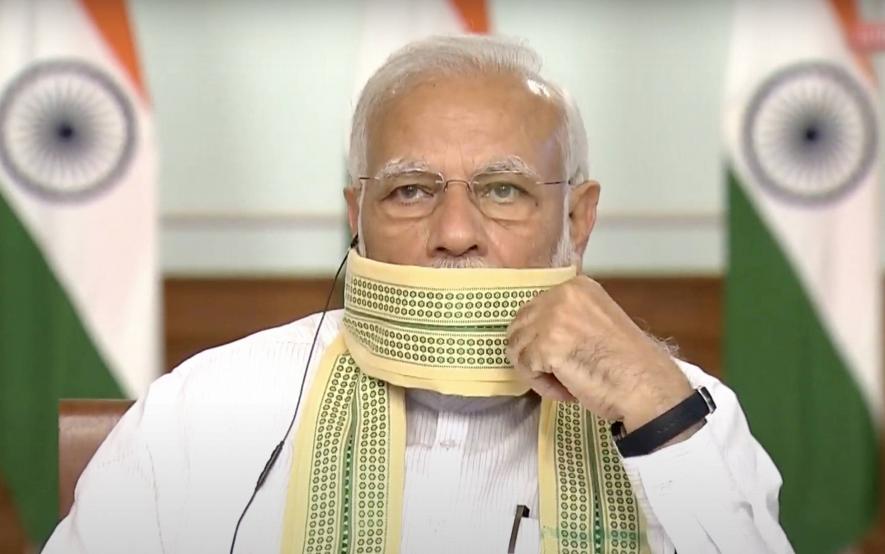Anxious Leader, Passive Citizens

Image Courtesy: PTI
We have seen major developments in the last few weeks despite the pandemic. On the one hand, major economic reforms that Prime Minister Narendra Modi is known for have been pushed through, first the National Education Policy and now the farm bills. These are major strides towards neo-liberal reforms that this government had been waiting to mount, since they always came with a possibility of public resistance and action.
Modi is looking to push through these reforms based on his personal popularity and deliver benefits to corporates by couching them in a nationalistic discourse. The game is becoming blatant and wide open. He will try to accelerate as many pro-corporate reforms as possible as his hold over resources and the media depends on these concessions and reforms. The false larger-than-life image of Modi that the media is building will continue only as long as he keeps making these reforms. But the more reforms he pushes the greater the likelihood of his popularity declining and popular resistance becoming stronger.
The Congress party under former prime minister Manmohan Singh was in a similar quandary, but managed it through instituting some social welfare measures. The Manmohan era of expansion of neo-liberal reforms also led to greater social and economic rights. It was this unhappiness with concessions that was depicted in the popular media as “policy paralysis” and later the narrative of corruption took over through Anna Hazare’s stage-managed and BJP-RSS-backed India Against Corruption show. Modi emerged as the new figurehead who could promise a bounty to corporates and global capital, and “acche din” to the common people, which meant not mere trickle-down benefits but great social and economic changes that will relocate India among developed countries, with fantastic growth rates and even more fantastic development.
Now, after a series of misadventures beginning with demonetisation, and followed by GST and the lockdown—alongside the global economic slowdown and an atmosphere of fear and vendetta—the Indian economy was collapsing and the promised reforms were nowhere in sight. As the domestic economy collapsed, foreign direct investors withdrew. In fact, under Modi both capital and labour got short-changed. From an imagined situation of expanding private capital and thereby maintaining the legitimacy of political rule, due to an exaggerated self-image and power of bulldozing majoritarian psyche, we have ended up with losses to the corporate sector and extensive loss of jobs and benefits to the working people, including the middle classes. What next?
This is when Modi shifted to provide policies that assure exclusive benefits to chosen corporates. That will ensure the funding and resources necessary to fight elections. He continues to control the media through these chosen corporate houses and therefore the ability to set and manage the narrative. He has exhausted the majoritarian cultural agenda of Article 370 and triple talaq in the zest to secure a second term and its immediate aftermath, which also saw the Ram Mandir fall in place. The pandemic, in a sense, put the brakes on the BJP’s plans, but it has also created the opportunity for the BJP to push through unpopular reforms. The Modi-led government still has four years left in its terms, and looking at the present situation, maintaining the momentum of the past few years appears difficult.
The Prime Minister’s strongest point seems to be the weak Opposition. It is not that the country lacks leadership in the opposition ranks, but that the opponents of the BJP lack a narrative that can promise anything very different from what Modi is already doing. In a sense, we are at a dead-end of neoliberalism, foisted on the country’s politics. For the moment, there is no popular resistance, and this could be because of the effect of the long lockdown and lingering persistent fear of Covid-19. With a non-responsive government and an absent opposition there is nobody to mobilise people around the discontent that is brewing. We are entering into an abyss of gloom. It is now clear that there cannot be “acche din” for people, nor one for the corporates and private capital.
What Modi can do with his remaining term is go ahead with his cultural majoritarian agenda driven by the RSS. Add to this a heightened nationalist discourse and continued benefits to a small segment of the corporate sector. Fear, extra-judicial decisions, undermining institutions including the judiciary, large-scale arrests and unaccounted management and accumulation of funds (as seen with PM-CARES), have been some modes through which the current situation is being controlled and preparations for the future are being made. What looks clear is that Modi will have to manage the rest of his term through artificially-managed narratives of the kind we witnessed around the death of Bollywood actor Sushant Singh, which, in fact, was apparently engineered with elections in Bihar in mind. [Sushant Singh came to Mumbai from his birthplace in Bihar.]
What we are also witnessing is the extreme dead-end of the self-contradiction which capitalism in its neo-liberal form is based on. Complete suppression contradicts even the basic minimum freedoms that capitalism itself requires. But the paranoid personality of the leadership and criminalised governance has pushed too strongly, even though it was unwarranted considering the popularity of Modi. Since this popularity is based on media images, an inbuilt insecurity has taken over the acceptance of the cultural-nationalist discourse among a large section of the Hindus. Though Modi still banks on his acceptance from the pursuit of the cultural-nationalist agenda, he seems to be aware of the possibility of a large-scale resistance to unpopular economic decisions. Therefore, he seems caught between celebrating popularity delivered by cultural majoritarianism, and fear of resistance due to the economic crisis. It is again a gamble that he needs to play—and for which he is known.
This see-saw ride is pushing not only a crisis but anxiety in the ruling elite. This is dangerous for a democracy. What we have today is a demobilised citizenry and an anxious leader; anxious of the future even as he enjoys popularity today. It is unusual to have an anxious leader with a popular mandate. How is he to maintain the status quo in the future and keep the current situation in a lull, when there is a possibility of civil, social and economic crisis deepening? This is where governance is getting recklessly criminalised. Every future possibility of mobilisation is being trampled upon, which is what explains the uncanny arrests, naming of public intellectuals (signalling their being next in line for questioning, arrest and trial), brazen lawlessness, and other possible means. We are either headed for a prolonged social crisis or the realisation of our worst nightmares, and this is making the leader anxious. As things stand today, the chances of the former weigh heavier than the latter.
The author is associate professor, CPS, JNU. His forthcoming book is titled Emotive Majority: Ethics and Emotions in New India. The views are personal.
Get the latest reports & analysis with people's perspective on Protests, movements & deep analytical videos, discussions of the current affairs in your Telegram app. Subscribe to NewsClick's Telegram channel & get Real-Time updates on stories, as they get published on our website.
























